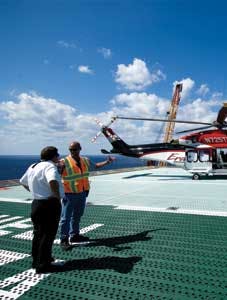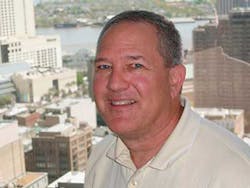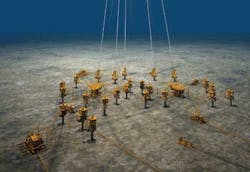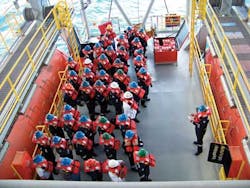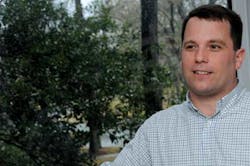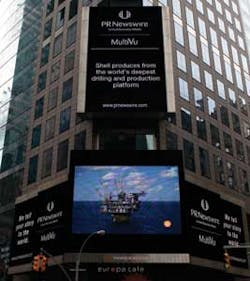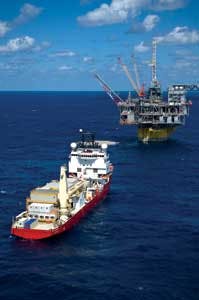Operations and surveillance
“On Perdido, the design team pulled Operations into every aspect of designing the topsides,” says Chris Smith, Perdido Operations manager. “At the end of the day, the project had our handprints all over it. Operation’s Arthur McAlpin was so instrumental in the design of the helideck, for example, that it’s nicknamed McAlpin International.”
“Four years before first oil, we began drawing staff from eighteen upstream and downstream locations to build the Perdido Operations team,” Smith says. “As we built the organization, we focused on team building to insure the success of our operation and the people who run it.”
The home team
Much of their time was spent running simulations, first on paper, then using advanced simulators and system modeling tools. Their job was to detail all the steps needed to start the facility and keep it running safely.
“They were looking for ways to do things safer, better, and faster,” Marsden says. “In doing that, the operations people become very familiar with the system.”
Another part of the work was to document all of the major health, safety and environmental risks, and to demonstrate how they are being managed. That helped the Operations team identify all of the procedures, maintenance jobs, inspections, emergency response people and equipment they’d need. The goal was to minimize risks. A helicopter landing officer, for example, is responsible for making sure the helipad is clear of debris, that people aren’t on the pad, and that a firefighter is standing by when an aircraft is coming in.
“That’s what we call an HSE Critical Activity,” Marsden says. “We put someone in charge because it is a major risk. In this case, we specify that certain duties are critical to preventing a major helicopter incident. We have identified hundreds of HSE Critical Activities for different people. We make sure they know that what they’re doing not only protects them, but everyone else on the platform.”
Learning is an ongoing activity, but much of the training for Perdido’s Operations staff came from being involved early on with the design and construction of the facilities. By the time Development was ready to hand over the keys, the Operations people were all experienced hands.
“The HSE case at the end is kind of anticlimactic, because, quite frankly, all of the operations folks are all very familiar with the platform, the risks, and their roles in preventing accidents,” Marsden says. “Unless there has been a last-minute adjustment, even the newest operators have been on board for some time. Their training was excellent.”
Transient Engineering Simulator
One of the first operating and surveillance tools the Perdido team developed was the Transient Engineering Simulator (TES).
“To understand and model the behavior of our wells, flowlines, and especially the artificial lift system, we needed to know Perdido’s fluid properties and flow conditions throughout the system,” says Gill Purdy, Production Technician.
A typical steady-state multiphase flow analysis yielded overall pressures and temperatures, which allowed the Operations team to plan for chemical injection, pipeline sizes and strategies for insulating the pipe. To predict the complex multiphase physics of Perdido’s closed-loop artificial lift system, however, they needed a Transient Engineering Simulator.
“Our simulator has a very intuitive interface,” Purdy says. “It is similar to operating the field with a Distributed Control System (DCS) that is equipped with a human-machine interface (HMI). Even parameters that are not instrumented in the field, such as pressure, temperature and liquid holdup throughout the flowlines and wellbores, are available in the simulator.”
On a PC laptop, the program can simulate three flowlines, five caissons with electric submersible pumps (ESPs), up to five multiphase concentric annular risers and more than 20 wells, all at speeds up to 20 times faster than real time.
“With this tool, we can study the health and behavior of our ESPs, manage the complex subsea boosting system and guide ourselves through transient situations, such as unplanned shutdowns,” Purdy says. “And since the simulator can run in a stand-alone mode, onshore surveillance support people can use it to optimize procedures as the field ages, or as a risk-management tool to study rare events such as aborted startups, interrupted blowdowns and cold-oil sweeps. Since the interface runs much faster than real time, it’s easy to investigate many circumstances and responses.”
Operations Training Simulator
The TES model itself became the calculation engine for an Operator Training Simulator (OTS), which runs the actual control code on the distributed-control system’s human-machine interface offshore. That allowed operators to train using realistic scenarios. The accurate physics of the simulator helped them test and refine procedures in relation to controls, instrument readings and human response.
“Our operator training program was a mix of classroom theory, guided lectures using the OTS, and hands-on exercises with one of our quad-monitor workstations,” Purdy says. “That realistic interaction generated both a high-quality learning experience for the operators and an extended shakedown of the operating system.”
ESP Surveillance tools
The Subsea Boosting System is one of the major new technologies deployed at Perdido. It consists of a 350-foot-long cyclonic vertical caisson separator that separates oil and gas on the seabed, directly beneath the spar. A powerful electrical submersible pump (ESP) at the bottom of the separator pumps liquids to the surface, while the gas flows to the surface on its own.
The ideal operating condition for the ESP is to maintain the liquid level at a point about half way up the separator vessel. The ESP’s performance depends on the properties of the fluid it is trying to move. More viscous fluids decrease the pump’s boost at a given flow rate, while entrained gas reduces the effectiveness of the impellers. Performance and reliability in general require a good understanding of the subsea boosting system and the caisson riser, and there is plenty of incentive to keep them running for a long time. Changing out an electric submersible pump can cost millions of dollars and weeks of deferred production.
Integrated Production System Modeling
Building a fit-for-purpose Integrated Production System Model (IPSM) for Perdido posed several unique challenges. The production system uses unconventional separation and lift technology that is difficult to model, and even trickier to integrate with other models.
“Perdido’s phased development plan needed a model that worked for both daily surveillance and for long-term development planning.” Purdy says. “Through a collaborative effort that drew on global expertise across many disciplines, the ISP and the model that Shell developed for Perdido began to add value long before first oil.”
The challenge in developing the IPSM for Perdido was the complex nature of its unique production system. Perdido also produces from fields that vary significantly in fluid properties. Recirculation lines that can route production from the surface back to the separator caissons adds yet another layer of complexity.
“The process of simplifying this complex technology into an integrated model required many approaches,” Purdy says. “By sharing knowledge with other Shell surveillance teams, we developed an improved solution to model the subsurface boosting system. The final product addresses both pump curve limits and the impact of changing fluid properties on a pump’s performance.”
To make the IPSM more user friendly for those with less modeling experience, a model manager was built in Excel software. It allows users to run scenarios in three modes: First, with only the reservoirs and wells, second, up to the caissons and the ESP, and third, with simplified surface facilities on. Results of multiple scenarios are automatically recorded in the model manager so the user can easily compare potential gains or losses.
Information Technologies and Processes
Satellites connect Perdido to onshore engineering support centers in Houston and New Orleans. These links provide secure access to the process control network in one of two ways. First, through the Process Control Access Domain (PCAD), and second, through direct connection to the Remote Control Room in New Orleans.
Perdido’s first oil was announced in New York City’s Times Square on March 31, 2010.
In addition to voice communications, the link supports a range of data acquisition and collaboration, enabling support staff and subject matter experts to work remotely.
The Process Control Access Domain allows controlled access to specific computers within the process control network. Through the PCAD, technical support staff in remote locations are granted access to select systems, which eliminates the need for the additional support staff to actually be aboard Perdido.
The remote control room (RCR) in New Orleans is an extension of the Perdido-based central control room. It is staffed by experienced control room operators who have full access to systems on Perdido. This facility allows surveillance engineers, Operations support staff, and technical support located in New Orleans to directly interact with the Operations people offshore. Video links between the RCR and Perdido’s control room enable operators in these two locations to interact directly. Remote access also allows surveillance engineers and vendors to see exactly what the offshore operators are seeing on their computers, which achieves a higher level of support.
“Although operating in ultra-deepwater is very challenging, the early use of our Surveillance and Operational tools allowed a smooth startup of this important asset,” Purdy says. “These technologies will also let us continue learning the reservoirs and improving our operation for many years to come.”
Perdido’s floating hotel
For more than eight months in 2009, most of Perdido’s offshore workforce lived aboard the HOS Achiever, a 430-foot multi-purpose service vessel (MPSV) operated by Hornbeck Offshore Services.
The dynamically-positioned Achiever, which normally carries fewer than 30 people at a time, was reconfigured to accommodate as many as 283 passengers and crew. Over the course of Perdido’s hookup and commissioning phase, there were more than 47,300 cumulative personnel transfers between the Achiever and the spar.

